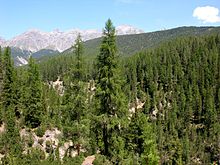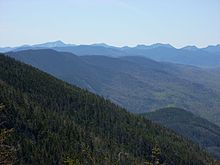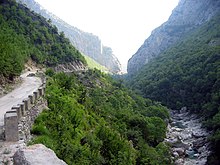Lasang
Ang lasang mao ang usa ka dako nga dapit nga gimandoan sa mga kahoy.[1] Gatosan ka sa mas tukmang kahulugan sa lasang nga gigamit sa tibuok kalibutan, sa paggamit sa mga hinungdan sama sa kahoy nga Densidad, kahoy nga gitas-on, paggamit sa yuta, legal nga baroganan ug ecological function.[2][3][4] Sumala sa kaylap nga gigamit[5][6] kahulugan Food and Agriculture Organization, kalasangan gitabonan sa upat ka bilyon ka ektarya (15 milyon milya kwadrado) o gibana-bana nga 30 porsyento sa yuta nga dapit sa kalibutan sa 2006.[4]



Kalasangan mao ang mga dominanteng terrestrial ecosystem sa Yuta, ug apod-apod sa tibuok kalibutan. Kalasangan account alang sa 75% sa gross nag-unang produksyon sa biosphere sa Yuta, ug naglakip sa 80% sa tanom biomass sa Yuta.[7]
Kalasangan sa lain-laing mga dapit ug mga habog nga mga dapit maporma sa matin-aw sa lain-laing ecozones: boreal kalasangan duol sa mga poste, tropikal nga kalasangan duol sa equator ug kasarangan kalasangan sa tunga-tunga sa latitudes. Mas taas nga gitas-mga dapit tambong sa pagsuporta sa kalasangan nga susama sa mga tawo sa mas taas nga mga dapit, ug sa kantidad sa ulan usab makaapekto sa kalasangan komposisyon.
Katilingban sa tawo ug kalasangan impluwensya sa usag usa sa duha positibo ug negatibo nga mga paagi.[8] Kalasangan sa paghatag ecosystem mga serbisyo ngadto sa mga tawo ug mag-alagad ingon nga tourist attractions. Kalasangan mahimo usab nga makaapekto sa panglawas sa mga tawo. Sa tawhanong mga kalihokan, lakip na ang pag-ani sa mga kapanguhaan sa lasang, mahimo negatibo makaapekto ekosistema lasang.
Mga pakisayran
usba- ↑ "Forest". Dictionary.com. Retrieved 2014-11-16.
- ↑ Schuck, Andreas; Päivinen, Risto; Hytönend, Tuomo; Pajari, Brita (2002). "Compilation of Forestry Terms and Definitions" (PDF). Joensuu, Finland: European Forest Institute. Retrieved 2014-11-16.
- ↑ "Definitions: Indicative definitions taken from the Report of the ad hoc technical expert group on forest biological diversity". Convention on Biological Diversity. Retrieved 2014-11-16.
- ↑ 4.0 4.1 "Forest definition and extent" (PDF). United Nations Environment Programme. 2010-01-27. Retrieved 2014-11-16.
- ↑ "Comparative framework and Options for harmonization of definitions". Second Expert Meeting on Harmonizing Forest-Related Definitions. FAO. Retrieved 2014-11-26.
- ↑ Johnson, F.X.; Pacini, H.; Smeets, E (2013). Transformations in EU biofuels markets under the Renewable Energy Directive and the implications for land use, trade and forests. CIFOR. p. 32. ISBN 9786028693813.
- ↑ Pan, Yude; Birdsey, Richard A.; Phillips, Oliver L.; Jackson, Robert B. (2013). "The Structure, Distribution, and Biomass of the World's Forests" (PDF). Annu. Rev. Ecol. Evol. Syst. 44: 593–62. doi:10.1146/annurev-ecolsys-110512-135914.
- ↑ Vogt, Kristina A, ed. (2007). "Global Societies and Forest Legacies Creating Today's Forest Landscapes". Forests and Society: Sustainability and Life Cycles of Forests in Human Landscapes. CABI. pp. 30–59. ISBN 9781845930981.
